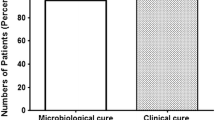Summary
The clinical effect and pharmacokinetics of the combination trimethoprim (TMP)-sulphadiazine (SD) were studied in 18 children with acute urinary tract infections (UTI), aged 2–56 months. A suspension of TMP-SD (9+41 mg/ml) was taken orally twice daily for 10 days. Various doses of TMP (2.9–3.7 mg/kg/day) and SD (12.9–16.7 mg/kg/day) were also given to children of different ages. After 2–4 days of treatment, bacterial cultures of urine were negative and C-reactive protein in serum, WBC count and ESR in all patients had become normal. Steady state serum levels for both components were reached after 4 or more days of treatment. At steady state, mean peak serum concentrations of TMP and SD of 1.4 µg/ml and 27 µg/ml, respectively, were found within 2–4 h after a fasting morning dose. The biological half-lives of TMP and SD were of the same order of magnitude, but the total clearance of TMP was 5 times greater than that of SD. The concentrations of TMP-SD in urine were invariably more than 10 times the minimum inhibitory concentrations (MIC) for the causative organisms (tested at the ratios 1:20 and 1:4 of TMP and SD). Non-metabolized SD constituted 77% of total SD in urine of infants, and 55% of total SD in children of 1 year or more. The TMP-SD combination showed a satisfactory clinical effect and favourable pharmacokinetic properties in children with UTI.
Similar content being viewed by others
References
Schwartz DE, Vetter W, Englert G (1970) Trimethoprim metabolites in rat, dog and man, qualitative and quantitative studies. Arzneim Forsch 20: 1867–1871
Siegel CW, Grace ME, Nichol CA (1973) Metabolism of trimethoprim in man and measurement of a new metabolite: a new fluorescence assay. J Infect Dis 128: 580–583
Nolte H, Buttner H (1974) Investigations on plasma levels of sulphamethoxazole in man after single and chronic oral administration alone and in combination with trimethoprim. Chemotherapy 20: 321–330
Nolte H, Buttner H (1973) Pharmacokinetics of trimethoprim and its combination with sulphamethoxazole in man after single and chronic oral administration. Chemotherapy 18: 274–284
Ohnhaus EE, Spring P (1975) Elimination kinetics of sulphadiazine in patients with normal and impaired renal function. J Pharmacokinet Biopharm 3: 171–179
Bergan T, Vik-Mo H, Ånstad U (1977) Kinetics of a sulfadiazine-trimethoprim combination. Clin Pharmacol Ther 22: 211–224
Closs O, Digranes A (1971) Rapid identification of prompt lactose-fermenting genera within the familyEnterobacteriaceae. Acta Pathol Microbiol Scand [B] 79: 673–678
Cowan ST, Steel KJ (1970) Manual for the identification of medical bacteria. Cambridge University Press, London
Ericsson HM, Sherris JC (1971) Antibiotic sensitivity testing. Report of an international collaborative study. Acta Pathol Microbiol Scand [B], Suppl 217
Sjøberg B, Bamberg P, Ekstrøm B, Forsgren A, Magni L, Pring BG (1978) Synergistic action in vitro between aminopenicillinanic acids and penicillins or cephalosporins. In: Siegenthaler W, Lüthy R (eds) Current chemotherapy, American Society for Microbiology, Washington DC, pp 432–434
Land G, Dean K, Bye A (1978) The gas-liquid chromatographic analysis of trimethoprim in plasma and urine. J Chromatogr 146: 143–147
Westerlund D, Wijkstrøm A (1982) Determination of sulfadiazine and4N-acetylsulfadiazine in biological fluids by liquid chromatography on silica gel with an aqueous buffer as mobile phase. J Chromatogr (in press)
Bratton AC, Marshall EK (1939) A new coupling component for sulfanilamide determination. J Biol Chem 128: 537–550
Kremers P, Duvivier J, Heusghem C (1974) Pharmacokinetic studies of co-trimethoxazole in man after single and repeated doses. J Clin Pharmacol 14: 112–117
Wilfert CM, Gutman LI (1975) Pharmacokinetics of trimethoprim-sulphamethoxazole in children. Can Med Assoc J 112 [Suppl]: 73–76
Patel RB, Welling PG (1980) Clinical pharmacokinetics of cotrimoxazole (trimethoprim-sulfamethoxazole). Clin Pharmacokinet 5: 405–423
Marks MI (1975) Pharmacokinetics and efficacy of trimethoprim-sulfamethoxazole in the treatment of gastroenteritis in children. Can Med Assoc J 112 [Suppl]: 33–34
Marks MI, Kazemi M, Hales B, Neims AH (1973) Pharmacokinetic studies of trimethoprim sulfamethoxazole in children with gastroenteritis. J Infect Dis 128 [Suppl]: 622–625
Huovinen P, Toivanen P (1980) Trimethoprim resistance in Finland after five years' use of plain trimethoprim. Br Med J 280: 72–74
Author information
Authors and Affiliations
Rights and permissions
About this article
Cite this article
Aarbakke, J., Opshaug, O., Digranes, A. et al. Clinical effect and pharmacokinetics of trimethoprim-sulphadiazine in children with urinary tract infections. Eur J Clin Pharmacol 24, 267–271 (1983). https://doi.org/10.1007/BF00613830
Received:
Accepted:
Issue Date:
DOI: https://doi.org/10.1007/BF00613830




